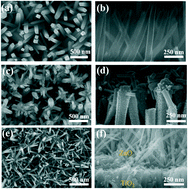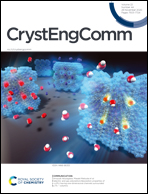Morphology-dependent photocatalytic and gas-sensing functions of three-dimensional TiO2–ZnO nanoarchitectures†
Abstract
Nanocomposites consisting of three-dimensional ZnO nanorods-decorated TiO2 nanorod templates (TiO2–ZnO) have been prepared by combining sputtering and hydrothermal growth strategies. The TiO2–ZnO heterostructures (TiO2–ZnO-1) were formed via an elevated temperature-grown ZnO seed layer-assisted crystal growth comprised of hexagonally structured ZnO nanorod branches on the top region and numerous ZnO nanoparticles on the sidewall region of the TiO2 nanorod template. In contrast, ZnO nanorods were randomly oriented on the top region of the TiO2 nanorod template by interweaving the neighboring segments via a room-temperature-grown ZnO seed layer-assisted crystal growth (TiO2–ZnO-2). The as-synthesized three-dimensional TiO2–ZnO nanoarchitectures exhibited significantly enhanced photocatalytic and photoelectrocatalytic performances towards the degradation of rhodamine B dyes under solar light irradiation as compared to the single-component counterparts. Moreover, the branched hexagonally structured ZnO nanorods in TiO2–ZnO-1 contributed to higher degrees of charge transfer ability and charge separation efficiency than those of the TiO2–ZnO-2 composite nanorods, explaining the superior photoactive performance of the TiO2–ZnO-1 composite nanorods under irradiation. The unique three-dimensional branched morphology of the TiO2–ZnO-1 composite nanorods also resulted in a greater number of potential barriers in the composite nanorod system, demonstrating their high gas-sensing performance towards ethanol vapor than that of the TiO2–ZnO-2. The control of the three-dimensional crystal morphology of the hydrothermally derived ZnO nanorods on the surface of the TiO2 nanorod template via changing the initial microstructures of the sputtering deposited ZnO seed layer is a promising approach to the design of three-dimensional TiO2–ZnO nanoarchitectures with desirable photocatalytic and gas-sensing functions.



 Please wait while we load your content...
Please wait while we load your content...